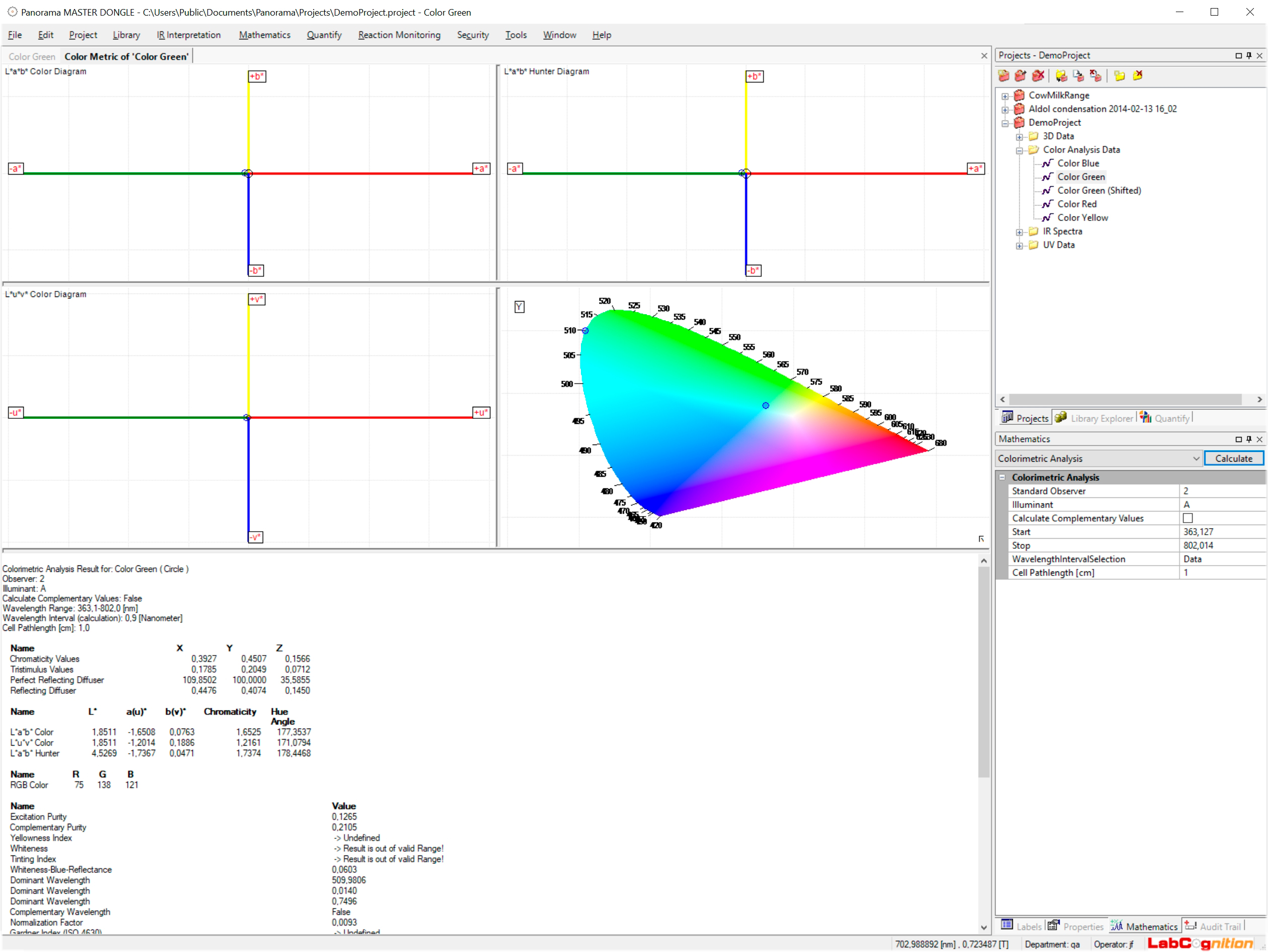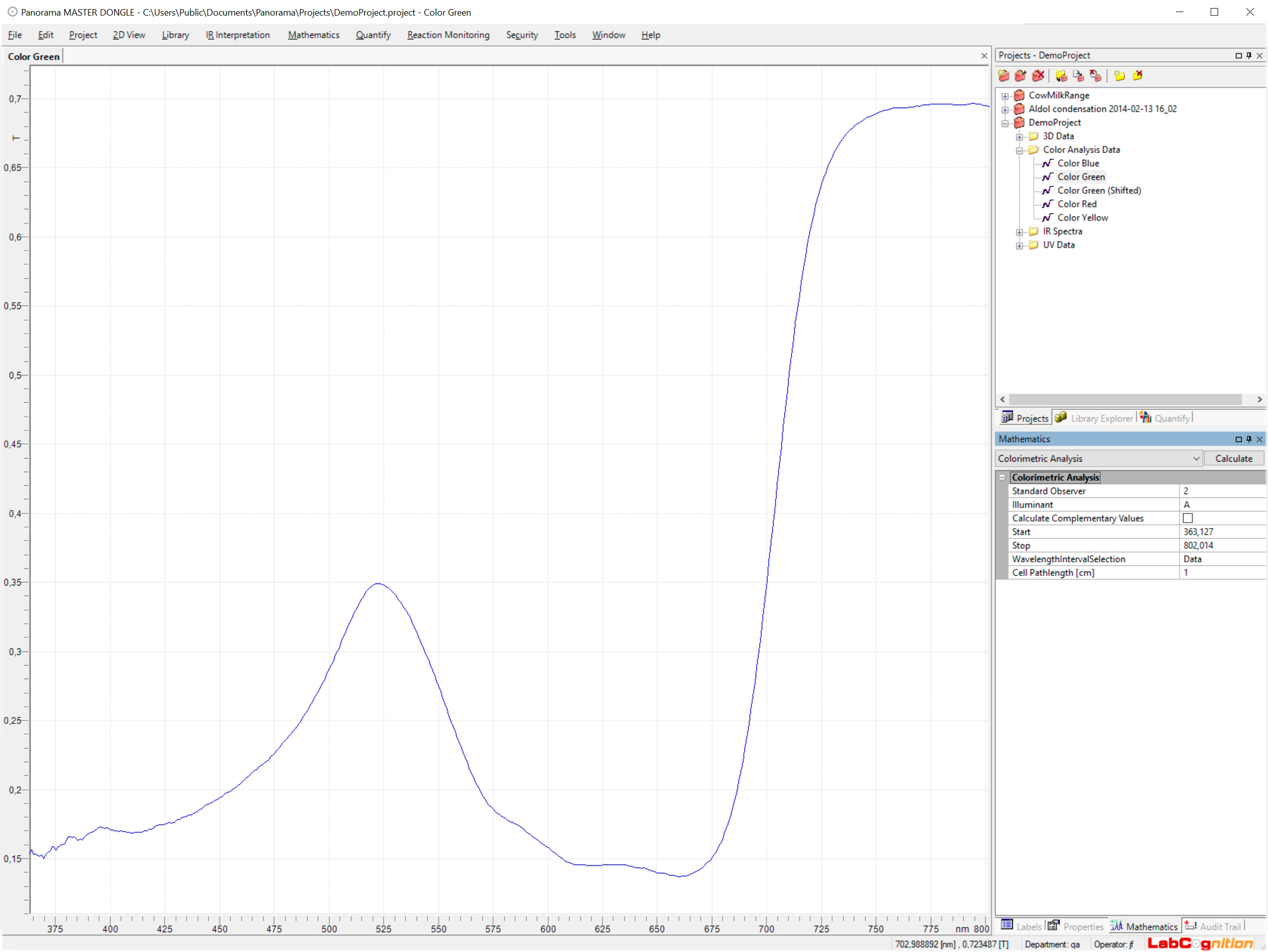Color Analysis & Comparison
Calculate characteristic color analysis values from UV/Vis spectra on single mouse click. Compare several color analysis results at a glance.
Color analysis is performed within 360 to 830 nm spectral range. Results are displayed in a comprehensive report including meaningful color plots.
Analyze and compare two or more spectra in a single analysis and determine color differences easily.
Last used analysis settings are kept for your convenience. Hence, batch sample analysis becomes a single click application. Save time and money by increasing your analysis efficiency with our color analysis and comparison. Results of color analysis provide valuable information on e.g. forensic, surface, coating, painting and damage analysis.
Data Preparation

Analysis is carried out using spectral data in its original spectral resolution or in either 1, 5, 10 or 20 nm resolutions. Required weighting factors are calculated according to ASTM E2022-16 and E2729-16 from tabulated 1 or 5 nm values. Measured sample spectra will be prepared according to methods described by Stearns et. al. improved by Fairman.
Standard Observers
The following standard observers are used according to CIE S 014-1:2006 and ISO 11664-1:2007 respectively:
- 2 degrees (CIE 1931)
- 10 degrees (CIE 1964)
Illuminants
Various illuminants can be used for color analysis including the CIE standard illuminants and also an enhanced set of further well known illuminants:
- A
(ISO 11664-2:2007 bzw. CIE S 014-2/E:2006)
Tungsten lamp; color temperature approx. 2856 K - D50, D55, D65, D75
(ISO 11664-2:2007 bzw. CIE S 014-2/E:2006)
Day light illuminants; color temperatures in range 5000-7500 K - ID50, ID65
(CIE 184:2009)
Indoor daylight illuminants; color temperatures in range 5000-7500 K - C
(CIE 15:2018)
Daylight illuminant; color temperatur approx. 6800 K - E
(CIE 15:2018)
Virtual uniform energy illuminant; color temperature approx. 5454 K - F1 ,F2 (formerly CWF), F3, F4, F5, F6, F7, F8, F9, F10, F11 (formerly TL84), F12
(CIE S014-2/E:2006)
White light of various fluorescent lamps with variable UV fractions - Custom Illuminants
Define your own illuminants by providing simple text files.
Tristimulus
Calculation of tristimulus values is the initial step in color analysis according to ASTM E308-18 and CIE 015:2018 respectively. Especially data preparation methods to resolve spectral resolution issues are applied. Tristimulus values are calculated according to CIE S 014-3:2011 and ISO 11664-3:2012 respectively.
Color Spaces
Color coordinates are determined for multiple color spaces:
- CIE 1976 Color Space
- L*a*b* Color Space
- L*u*v* Color Space
- Hunter L*a*b* Color Space
- RGB Color Space (24 bit) according to ISO 61966-2-1:2000 and A1:2003
The resulting color parameters are displayed in corresponding plots, and related values are summarized in a comprehensive report. Various standard or custom light sources and the CIE standard observers (2° and 10°) can be adjusted to match required analytical conditions.
Colorimetric results can be easily stored, printed as a report, or transferred into other applications such as Word or Excel.
Further important Values
- Chromaticity Values
- Hue Angle
- Dominant or Complementary Wavelength
- Whiteness (ASTM E313-15)
- Tinting Index (ASTM E313-15)
- Gardner Index (ISO 4630-2:2004)
- Hazen/APHA/Pt-Co number (ISO 6271:2015)
- Whiteness-Blue Reflection
- Yellowness Index (ASTM E313-15)
- Excitation and Complementary Purity
Feel free to contact us if you're interested in expanding your software with the Color Add-on Module.
